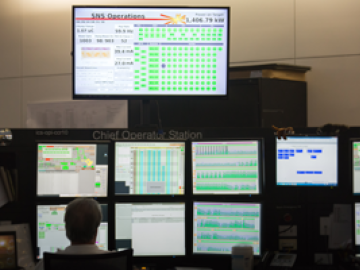Filter News
Area of Research
- (-) Fossil Energy (3)
- (-) Quantum Condensed Matter (4)
- Advanced Manufacturing (34)
- Biological Systems (18)
- Biology and Environment (177)
- Biology and Soft Matter (5)
- Building Technologies (12)
- Chemical and Engineering Materials (4)
- Chemistry and Physics at Interfaces (11)
- Clean Energy (522)
- Climate and Environmental Systems (14)
- Computational Biology (6)
- Computational Chemistry (5)
- Computational Engineering (5)
- Computer Science (19)
- Data (1)
- Earth Sciences (1)
- Electricity and Smart Grid (3)
- Energy Frontier Research Centers (14)
- Energy Sciences (5)
- Fuel Cycle Science and Technology (3)
- Functional Materials for Energy (16)
- Fusion and Fission (54)
- Fusion Energy (17)
- Geographic Information Science and Technology (3)
- Isotope Development and Production (3)
- Isotopes (35)
- Materials (432)
- Materials Characterization (2)
- Materials for Computing (36)
- Materials Synthesis from Atoms to Systems (13)
- Materials Under Extremes (12)
- Mathematics (1)
- National Security (78)
- Neutron Data Analysis and Visualization (4)
- Neutron Science (190)
- Nuclear Science and Technology (74)
- Nuclear Systems Modeling, Simulation and Validation (3)
- Nuclear Systems Technology (1)
- Quantum information Science (9)
- Reactor Technology (1)
- Renewable Energy (4)
- Sensors and Controls (5)
- Supercomputing (311)
- Transportation Systems (11)
News Type
Media Contacts

To improve models for drilling, hydraulic fracturing and underground storage of carbon dioxide, Oak Ridge National Laboratory scientists used neutrons to understand how water flows through fractured rock.

Scientists at the Department of Energy’s Oak Ridge National Laboratory have found a simple, reliable process to capture carbon dioxide directly from ambient air, offering a new option for carbon capture and storage strategies to combat global warming.
Initia...

In a new twist to waste-to-fuel technology, scientists at the Department of Energy’s Oak Ridge National Laboratory have developed an electrochemical process that uses tiny spikes of carbon and copper to turn carbon dioxide, a greenhouse gas, into ethanol. Their findin...

Advances in ultrathin films have made solar panels and semiconductor devices more efficient and less costly, and researchers at the Department of Energy’s Oak Ridge National Laboratory say they’ve found a way to manufacture the films more easily, too.
Typically the films—used b...

Groundbreaking work at two Department of Energy national laboratories has confirmed plutonium’s magnetism, which scientists have long theorized but have never been able to experimentally observe. The advances that enabled the discovery hold great pro...

The Spallation Neutron Source at the Department of Energy’s Oak Ridge National Laboratory broke records for sustained beam power level as well as for integrated energy and target lifetime in the month of June.

The American Conference on Neutron Scattering returned to Knoxville this week, 12 years after its inaugural meeting there in 2002.




